What to do if rust appears on honeysuckle leaves and how to treat it
Diseases and pests are the most common cause of crop loss and death of honeysuckle. The disease is caused by a parasitic fungus that gradually destroys all parts of the plant. It becomes covered with red formations, from which rusty powder pours out.
Rust occurs equally in ornamental and edible plant varieties. Without timely treatment, it leads to the death of the entire bush. Fungal disease can be cured if its signs are noticed in time. What are the symptoms and causes of rust on honeysuckle leaves and how to treat the plant, read on.
Description of the disease
Rust is a fungal disease that attacks crop plants. It is caused by a whole group of fungi. Moreover, some pathogens are able to develop only on an infected host plant, while others spread throughout the garden to all plants.
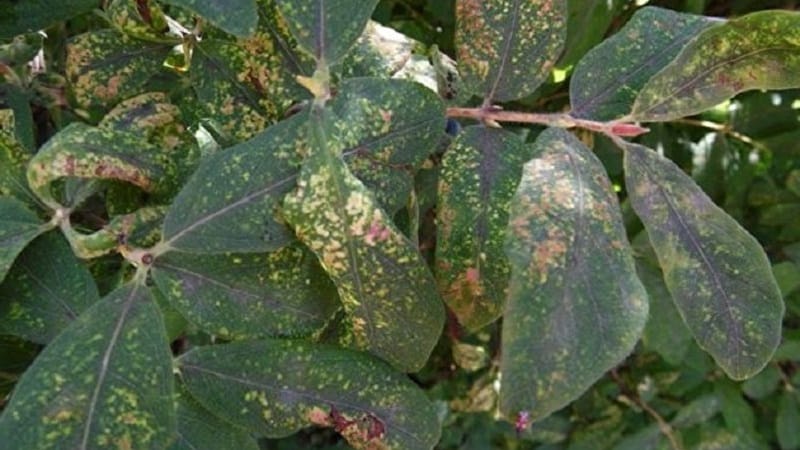
The infection affects the leaves first, and then all parts honeysuckle. Progresses slowly. Typically, honeysuckle is infected with a fungus in early spring. In this case, pustules with spores form only in mid-summer.
note! In areas where juniper and ornamental conifers grow, the risk of honeysuckle rust infection increases significantly.
Rust affects almost all fruit and berry trees and shrubs. Especially often suffers from this illnesses honeysuckle.
Signs of defeat
It is easiest to treat the disease in the initial stages of its development. In order to detect rust in a timely manner, it is important to know its symptoms and stages of development:
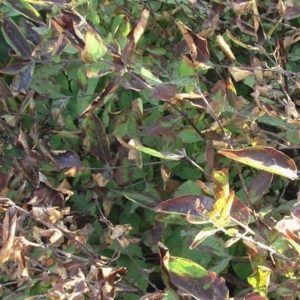
- Flat, dry spots of reddish or reddish color appear on the inside of the leaf. Light yellow spots of irregular shape form on the outside of the leaf blade.
- The infection spreads to young shoots. Brown and red spots appear.
- Over time, the spots become covered with yellow and orange pustules (pads). When ripe, they release a rusty powder. These are fungal spores.
- Convex formations merge into large curved stripes. Over time, they peel off from the surface of the affected part of the plant.
- Already in August, the leaves dry out, curl up and fall off. Infected shoots die.
The speed at which the disease spreads through parts of the plant depends on the causative fungus. Some types of rust attack honeysuckle locally.
Note! Regardless of the pathogen, the symptoms of rust are always the same. They can be seen in the photo.
Causes
To get rid of the disease forever and prevent its recurrence, it is important to understand why the leaves rust. The main reason is the contact of fungal spores with the plant. Their active development is provoked by the following factors:
- Pests. Insects and mites carry many plant diseases, including rust. A plant affected by pests has reduced immunity, which allows the fungus to take root on it faster. Birds also carry spores.
- Weeds. They suffer from rust, infecting nearby cultivated plants. The proximity to sorrel, sedge, barley, and cereals is especially dangerous. These plants are called intermediate hosts.
- Coniferous plants. It is believed that they are the most susceptible to rust and become its carriers. Honeysuckle growing in the same area as any coniferous plants or located in an area near a forest is especially susceptible to rust.
- Plant remains. Fungal spores overwinter in fallen leaves. Remains of weeds and cultivated plants on the site also contribute to infection of honeysuckle.
- High humidity. Like most other fungi, the honeysuckle pathogen is activated in damp, cloudy weather. The risk of plant infection is especially high after heavy rains.
- Cold snaps and sudden temperature changes. These factors reduce the plant’s immunity and promote the proliferation of the fungus.
The fungus is spread throughout the area not only by pests, birds and plants, but also by the wind. It is impossible to completely eliminate the possibility of rust developing on honeysuckle.
Danger
Rust not only spoils the appearance of cultivated plants. It poses a real threat and, without treatment, leads to the death of the bush.
When affected by rust, the leaves and shoots of the plant begin to quickly lose moisture, wither and dry out. The leaf blades curl. All leaves from honeysuckle fall off prematurely. Often the fruits do not have time to set. The shoots fall off.
The plant stops developing. New shoots don't grow.
Honeysuckle photosynthesis deteriorates, immunity weakens, and frost resistance decreases. Affected crops often do not survive the winter and die.
Note! Due to the decreased immunity of honeysuckle when affected by rust, the likelihood of infection with other diseases increases.
Rust on decorative and edible honeysuckle
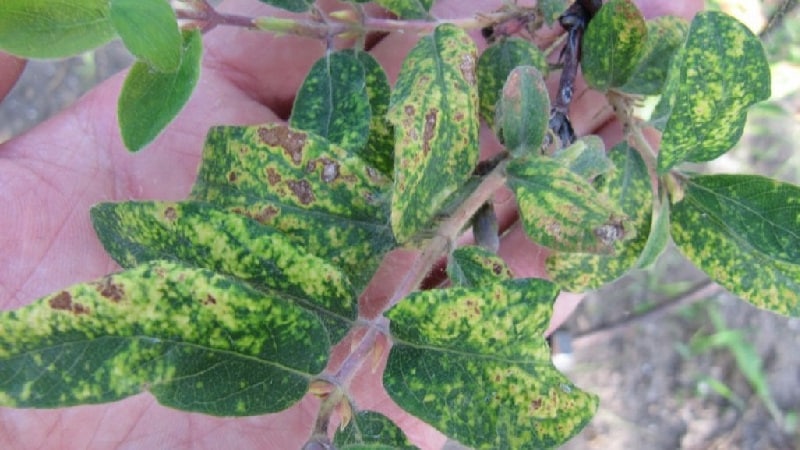
The symptoms of rust on the decorative honeysuckle vine and shrubs with edible fruits are the same. Rusty leaves, pustules with red spores and flaking streaky spots appear on all varieties infected plant.
There are differences in the treatment of different types of honeysuckle. If in the case of a shrub on which fruits develop, after the formation of inflorescences, only biological products and folk remedies are allowed, then the ornamental plant is treated with effective chemicals at any time of the year.
Also, the liana better tolerates global pruning. If you remove absolutely all the affected parts, this will not cause harm to the plant, and it will quickly compensate for the removed parts. Removing a large number of branches and shoots from edible honeysuckle will cause a decrease in yield, and new shoots will take longer to grow.
Rust treatment methods
If the leaves and shoots of honeysuckle are rusty, it’s time to treat it. The fungus is afraid not only of chemicals, but also of some folk remedies.
Traditional methods
Folk remedies are the cheapest and safest. Many gardeners prefer to use them. For their production, food, organic fertilizers, garden waste and pharmaceuticals are used.
The disadvantage of this method is its low efficiency. It will be possible to get rid of the disease with the help of folk recipes only in the early stages of its development:
- Iodine and whey. 2 liters of whey are poured into a 10 liter bucket and 20 drops of iodine are added. The rest of the volume is added with water. All ingredients are mixed. The drug is sprayed on the plant and the soil around it.
- Manure. 2 kg of rotted manure is poured into 6 liters of water. The ingredients are mixed and allowed to brew for a week.After this time, the mixture is stirred again and filtered.
- Hydrogen peroxide and boric acid. 10 tablets of hydrogen peroxide, previously crushed into powder, and 5 g of boric acid are dissolved in 10 liters of warm water.
- Aspirin, oil and soda. To 10 liters of water add 3 aspirin tablets crushed to a powder, 3 tbsp. l. sunflower oil, 3 tbsp. l. anti-dandruff shampoo and 3 tbsp. l. soda All ingredients are thoroughly mixed until completely dissolved.
- Herbal infusion. The bucket is filled 1/3 with weeds. The rest of the volume is filled with warm water. The product is infused for a week, then filtered and used for spraying.
Agrotechnical techniques
At the initial stages of disease development, some agricultural techniques are also effective. If several leaves with yellow spots appear, they are torn off to avoid the spread of the disease. Diseased shoots are cut 10 cm beyond the lesion.
After all diseased parts have been removed from the honeysuckle, it is treated with preparations containing copper (copper sulfate, Bordeaux mixture). Otherwise, there is a high risk of relapse.
Biological products
Biological products are sold in gardening stores. They are also effective against rust and are safe for the environment and humans. They are considered less effective than fungicides, but if yellow leaves are detected in a timely manner, they can cope with the fungus.
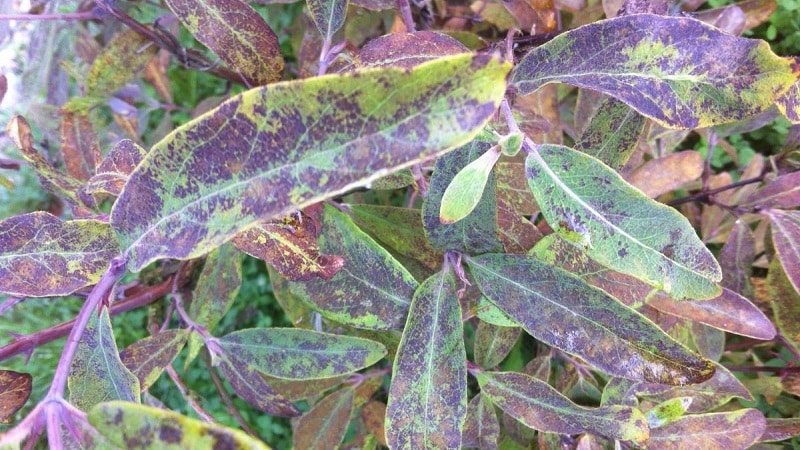
Biological products are made from bacteria, which, when they come into contact with the fungus, destroy it. The most popular means are:
- "Fitosporin". Biological fungicide that is effective against fungal diseases.It is this that is usually used in preventive and therapeutic treatments, in which the product covers the leaves and shoots of honeysuckle with a mesh that prevents the development and entry of the fungus. For spraying, 6 g of the drug is diluted in 10 liters of water.
- "Binoram." Contains two types of bacteria that not only protect honeysuckle from rust, but also stimulate its growth. To prepare a solution, dilute 75 ml of the product in 10 liters of water.
- "Baktofit". Effective against most fungal diseases. It is used for spraying honeysuckle in the form of a 1% solution.
- "Alirin." A relatively new, highly effective drug. It is used to treat diseased plants and the soil around them.
It is biological products that are recommended to be used for preventive treatment of not only already growing honeysuckle, but also soil with planting material. The described means, in addition to antifungal properties, stimulate the growth of honeysuckle.
Chemicals
Chemical agents are considered the most effective. They save the plant even in the later stages of infection. Such remedies protect it from re-infection for a long time.
Drugs that are used to control fungal infections are called fungicides. They are recommended to be used for decorative honeysuckle, the fruits of which are not eaten. With the help of such remedies, the disease can be cured in a short time.
Edible honeysuckle can only be treated with chemicals before flowering. After this, they negatively affect the quality of the fruit. If the berries have already appeared, the use of aggressive fungicides is prohibited. Toxic substances not only remain on the surface of the berries, but are also absorbed inside.
The most popular drugs for combating rust on honeysuckle:
- "Abiga Peak". Fungicide containing copper. Effective against all fungal diseases. To prepare the solution, add 40 g of the product to a bucket of water at room temperature. To cope with the disease and prevent relapse, honeysuckle is treated 3 times. Intervals between treatments should be 2 weeks. This is exactly how much the drug protects the plant from re-infection.
- "Topaz". A systemic fungicide that is particularly popular due to its speed and effectiveness. To treat the disease, 2 g of Topaz is diluted in 10 liters of water.
- "HOME." Fungicide of medium toxicity. Considered harmless to mammals. To prepare the solution, 30 g of the drug is dissolved in a bucket of water.
- "Strobe". Effective against all fungal diseases. To prepare the product, dissolve 2 g of the substance in a bucket of water.
Infected honeysuckle is sprayed with the described means. They are not washed off during precipitation, provided that they have had time to be absorbed into the plant cells. It is recommended to treat not only the plant, but also the soil around it.
Note! Fungi develop immunity to fungicides. In case of re-infection, a different drug is used.
How to deal with rust correctly
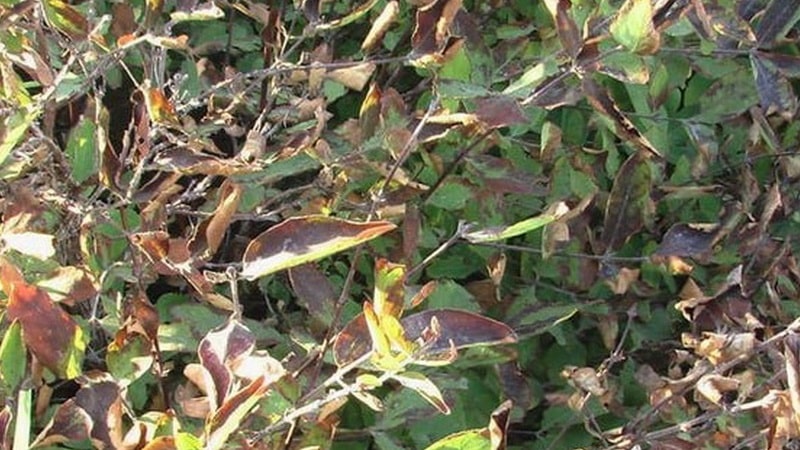
To cope with rust, it is important to know the basic rules of processing:
- Before spraying, cut off all infected shoots and remove leaves with spots. The cut areas are covered with garden varnish.
- All weeds and plant debris around the diseased bush are removed and burned. It is recommended to thoroughly loosen the soil.
- Treatment is carried out early in the morning or in the evening, when the sun is inactive. Otherwise, burns will remain.
- Do not exceed the indicated dosages.This will not help get rid of rust faster, but will only increase the risk of plant death.
- When working with plant medicines, you need to wear gloves and a protective mask.
- Despite the fact that fungicides are not washed off by rain, there will be no effect if you treat honeysuckle with them later than 32 hours before precipitation.
Timing and scheme for processing bushes
The timing and scheme for processing honeysuckle depend on the type of product used:
- Fungicides. They are not washed off with water and remain on the plant for 10 to 14 days. Approximately this interval should be between treatments. To treat rust, 3 chemical treatments are sufficient.
- Biological products. On average, a diseased plant is treated with such agents 3-4 times with a break of 1 week.
- Folk remedies. Washed away by precipitation. Treatment is carried out once every 5-7 days. To get rid of rust, 3 to 5 treatments are required.
Rust-resistant honeysuckle varieties
To prevent honeysuckle from rust, it is worth choosing varieties that are resistant to the causative agent of this disease. These include:
- Blue spindle;
- Bakchar giant;
- Moraine;
- Blue bird;
- Long-fruited;
- Leningrad giant;
- Kamchadalka.
Preventive measures
To avoid infection of honeysuckle with rust, gardeners engage in prevention:
- In autumn, be sure to remove fallen leaves and plant debris. They are taken away from the site and burned.
- In the fall the site is dug up.
- Honeysuckle is isolated from conifers.
- In early and late spring, the crop is sprayed with biological products or containing copper. Preventative treatments must be carried out after prolonged rains.
- The area around the honeysuckle is weeded.
- Pests are controlled in a timely manner.
Conclusion
Rust is a dangerous disease that affects many cultivated plants.It leads to a decrease in honeysuckle yield and death. The disease is recognized by red spots on leaves and shoots and formations with rusty powder inside.
It is possible to cure rust. To do this, you need to remove all affected leaves and shoots from the honeysuckle, and then treat the plant with a homemade or purchased antifungal agent. Compliance with the rules of prevention reduces the likelihood of relapse.